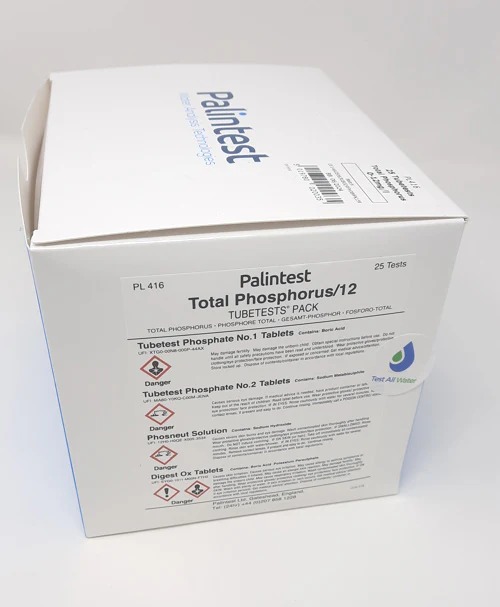Tubetest,Total Phosphorus 12, for 25 Tests, 0-12mg/L P
Catalog No :
CAS Number :
Brand :
In Stock
Specifications:
| Application | Water Quality Analysis |
| Storage Temperature | Room Temperature |
| Product Type | Photometer Reagent |
| Product Brand | Palintest |
| Product Grade | Analytical grade |
Total Phosphorus/12
Test Method Technical Information
TECHNICAL SPECIFICATION
Tests For: Phosphate Compounds in Natural and Wastewater
Tests Range: 0–12 mg/L P
Reagent Chemistry Used: Digestion with acid persulfate, then ascorbic acid/molybdenum blue
Basis of Test Method: Standard Method 4500-P-B and Standard Method 4500- P-E
Method Detection Limit*: 0.06 mg/L
Limit of Quantification**: 0.2 mg/L
*The Method Detection Limit (MDL) is defined as the minimum measured concentration of a substance that can be reported with 99% confidence to be different from the method blank results.
**The Limit of Quantification (LOQ) is the smallest quantity that can be detected with reasonable certainty for a given analytical procedure.
Testing for Total Phosphorus
Total Phosphorus is composed of orthophosphates, polyphosphates and organic phosphorus compounds. Ortho and polyphosphates are extensively used in detergent formulations and washing powders. Phosphates also find widespread application in the food processing industry and in industrial water treatment processes. Agricultural fertilisers normally contain phosphate minerals. Phosphates also arise from the breakdown of plant materials and are found in animal wastes. Organic phosphate compounds are used in industrial and water treatment applications; and arise from certain manufacturing processes.
Phosphorus compounds can therefore enter water courses through a variety of routes – particularly domestic and industrial effluents and run-off from agricultural land. Phosphates are associated with eutrophication of water and with rapid unwanted plant growth in rivers and lakes.
The Total Phosphorus test is a vital test for assessing the quality of effluents and wastewater prior to discharge. In the UK the Urban Wastewater Treatment Regulations make provision for the control of discharge of total phosphorus to sensitive bodies of natural waste water. The monitoring of the rate of phosphorus removal is therefore of great importance in wastewater treatment. The Palintest Tubetests Total Phosphorus Test provides a simple method of measuring total phosphorus compounds over the range 0–12 mg/L P.
Reagent Chemistry
The Palintest Tubetests Total Phosphorus/12 test is a two-stage procedure. The sample is first digested with acid persulphate to break down polyphosphates and organic phosphorus compounds and convert them to orthophosphate. The resulting orthophosphate, together with that originally present in the sample, is then determined by reaction with ammonium molybdate and ascorbic acid to form the intensely coloured ‘molybdenum blue’ complex. In this way, the total phosphorus content of the sample can be determined. A catalyst is incorporated to ensure complete and rapid colour development, and an inhibitor is used to prevent interference from silica.
The intensity of the colour produced in the test is proportional to the total phosphorus concentration and is measured using a Palintest Photometer
STEP ONE

Turn on heater block and set temperature to 105⁰C. Note: Timer may need setting above zero for warm up to start.
STEP TWO
 Add 2 mL of sample to a Tubetest.
Add 2 mL of sample to a Tubetest.
STEP THREE
 Add two Digest Ox tablets and crush and stir.
Add two Digest Ox tablets and crush and stir.
STEP FOUR
 Set timer on heater block to 60 minutes.
Set timer on heater block to 60 minutes.
STEP FIVE
 Place the tube in the heating block.
Place the tube in the heating block.
STEP SIX
 Ensure safety screen is in position and allow digestion to take place for 60 minutes.07
Ensure safety screen is in position and allow digestion to take place for 60 minutes.07
STEP SEVEN
 Carefully remove tube and place in a rack to cool.
Carefully remove tube and place in a rack to cool.
STEP EIGHT
 Fit the Tubetest adapter to Lumiso. Then, place an unused Total Phosphorous Tubetest in cell holder and press Blank
Fit the Tubetest adapter to Lumiso. Then, place an unused Total Phosphorous Tubetest in cell holder and press Blank
STEP NINE
 Removed the digested tube from the rack and add 2 mL of PhosNeut Solution
Removed the digested tube from the rack and add 2 mL of PhosNeut Solution
STEP TEN
 Continue with the same tube by adding a Tubetest Phos No1 tablet. Crush and stir, until fully dissolved.
Continue with the same tube by adding a Tubetest Phos No1 tablet. Crush and stir, until fully dissolved.
STEP ELEVEN
 Then, add a Tubetest Phos No2 tablet and crush and stir.
Then, add a Tubetest Phos No2 tablet and crush and stir.
STEP TWELVE
 Ensure cap is tight, then invert tube a few times to mix.
Ensure cap is tight, then invert tube a few times to mix.
STEP THIRTEEN
 Place in the cell holder and press Measure.
Place in the cell holder and press Measure.
STEP FOURTEEN
 Allow timer to count down 10 minutes. The concentration of Total Phosphorous will then be displayed
Allow timer to count down 10 minutes. The concentration of Total Phosphorous will then be displayed




 0
0
